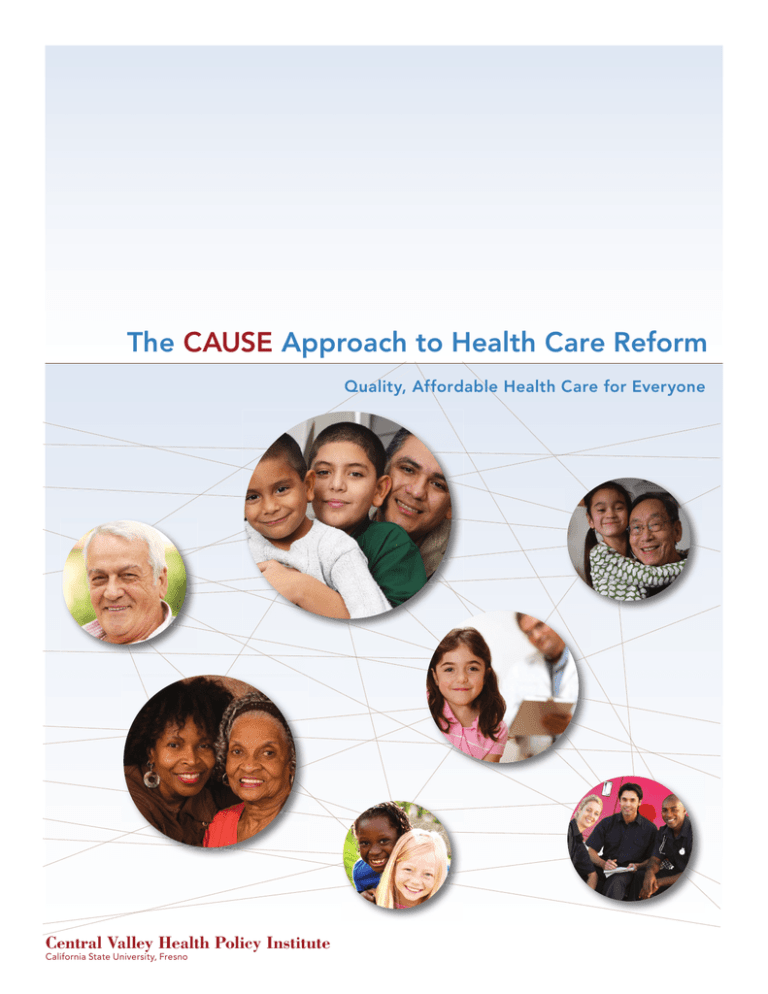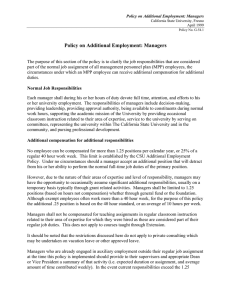The Approach to Health Care Reform CAUSE
advertisement

The CAUSE Approach to Health Care Reform Quality, Affordable Health Care for Everyone Central Valley Health Policy Institute California State University, Fresno What is CAUSE? CAUSE is a comprehensive approach to health care reform that began as a frank discussion between a doctor and his patient about the problems of the current health care system. Two years later that physician and experts at the Central Valley Health Policy Institute, California State University, Fresno, created a comprehensive approach to health care reform: CAUSE. The CAUSE team resides in one of the most underserved regions in the nation— a region that is similar to many in the U.S. Their personal experiences with a system that denies basic health care to millions augments the expertise they bring to this work. CAUSE is not only an approach, but also a detailed plan for a rational overhaul of the nation’s current ineffective, unfair, and nearly bankrupt health care system —a system that fails to provide any health coverage to some 47 million people. CAUSE stands for the five principles defined by the Institute of Medicine as critical to guiding the reform of the health care system: Continuous coverage, with no lapses Affordable to individuals, businesses, and government Universal in that everyone has access to a basic level of care Sustainable because everyone contributes, everyone participates, and costs are managed Effective in providing high-quality care to everyone What is our plan? The CAUSE plan builds on Medicare and transforms it over a 15-year period into a system that ensures everyone in the U.S. has access to a basic level of quality health care, while maintaining the private insurance market. The CAUSE approach would save $1.8 trillion dollars over the first 10 years of the plan’s implementation. This long-term commonsense approach to implementing complex reforms will ensure success by providing sufficient time to build the technology and human capacity necessary to guarantee quality care for everyone. Equitable distribution of resources and capacity among regions, a larger system of trained and qualified primary care providers, health information technology, and a system focus on evidence-based and preventive care will all be realized by full implementation. The CAUSE approach accomplishes the short- and long-term objectives of making us healthier and it begins by covering our children. It relieves employers of the responsibility of providing health insurance to their employees and eliminates the workers’ compensation and automobile insurance systems’ roles in providing health care coverage. These changes would improve administrative efficiency and result in lowering both workers compensation and automobile insurance costs. The CAUSE plan is about ensuring continuity and choice. People will be able to go to their own physician for care. Because CAUSE focuses on providing the basic level of care everyone deserves, there is still a role for private insurance. Individuals and families have the option to buy supplemental policies for deductibles and services beyond the basic level of care not covered by the CAUSE plan. The CAUSE approach builds on the best elements of the U.S. health system, preserving the choice of physicians and delivery systems through each phase of implementation and, although core financing is public, the delivery of care still remains private. Built on the Institute of Medicine’s guiding principles for an effective system of coverage, at full implementation the CAUSE plan: Provides continuous care with no coverage lapses…ever Once people are enrolled into the system they will remain enrolled their entire life. Gaps in coverage would end. Eligibility will be continuous because coverage is not employment-based. Is affordable to individuals and businesses No longer required to pay health care premiums for employees, the financial burden on employers would decrease. Premiums for workers’ compensation and automobile insurance would drop. The various revenue sources, including a financial transaction tax, would spread financial responsibility more broadly. Lack of co-pays for evidence-based services and some cost sharing for less necessary services would remove barriers to necessary care, but limit overutilization of the health care system. Provides universal coverage Everyone in the U.S. would be enrolled. Individuals who fail to register initially would automatically be registered when seeking services. Is sustainable because all stakeholders share in cost and delivery More health care providers will be available to serve the increased number of insured. Cost increases will be contained. State and sub-state-region health boards will create annual CAUSE budgets. Is effective and efficient Resources will be directed to the prevention and management of chronic disease, making people healthier. Resources will be systematically distributed to underserved areas, making care accessible to everyone. Will it save money? The CAUSE plan will save at least $1.8 TRILLION dollars over the first 10 years of its implementation. These savings will be achieved through: Lower administrative costs from federal financing of the CAUSE plan and having private insurance fund supplemental health coverage Redesign of the Medicare Advantage program Altered fee schedules and a reduction in economic incentives for physicians to do medically unnecessary procedures and tests Federal financing that will better withstand economic downturns, unlike state and local funding The implementation of health information technology and evidence-based medicine Promotion of health and disease prevention to achieve reductions in obesity and tobacco use Elimination of federal tax exemptions for premium contributions when CAUSE is fully implemented Negotiation of prescription drug prices and limitation of payment updates, especially in high-cost areas The streamlining of eligibility rules, as well as lessening billing infrastructure for hospitals, physicians offices, and outpatient facilities Elimination of medical coverage in workers’ compensation Elimination of medical coverage in car insurance resulting in lower premiums and lower administrative costs How will we pay for it? Revenue to pay for CAUSE will come from: A financial transaction tax of 0.5% on sale of stocks, smaller fees on trading of government and corporate bonds, futures contracts, currency swaps, and options ($120-$150 billion annually) Increased tax on tobacco of up to $5 dollars a pack Continued revenue sources for present day Medicare and Medicaid paid out of general revenues A 2% national sales tax and a 3.3% payroll tax increase may be needed after 2025 How is the CAUSE plan different? CAUSE takes the time to build an effective health care system—in three phases over 15 years—spreading costs and building human and technological capacity. CAUSE provides all Americans access to a basic level of health care while retaining the role of private insurers as a source of supplemental coverage. CAUSE addresses health disparities by equitably distributing resources and building capacity in traditionally underserved communities. CAUSE ends employee dependency on employer-provided insurance and relieves employers of the cost and administrative burden of providing it. CAUSE streamlines our system of care by removing the workers’ compensation and automobile insurance systems’ roles in providing medical coverage. CAUSE contains costs through annual budgeting, improved coordination of care with a strong primary care system, and a fee structure that supports services proven to make people healthier. CAUSE provides affordable, quality health care to all. Where do I get more information about the CAUSE plan? Marlene Bengiamin, Ph.D. Senior Research Associate Central Valley Health Policy Institute California State University, Fresno 1625 East Shaw Avenue, Ste. 146 Fresno, CA 93710-8106 P 559.228.2167 F 559.228.2168 Email: marleneb@csufresno.edu www.cvhpi.org





